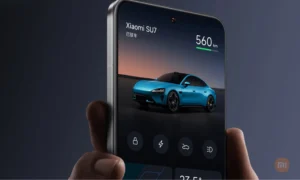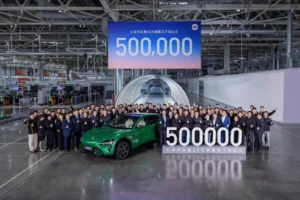Xiaomi Auto: 50,000 EVs in Record Time!
Xiaomi Auto revolution. # From Zero to 50,000: The Astonishing Rise of Xiaomi Auto and Its Electric Vehicle Revolution
Imagine a world where established automotive giants take years to reach significant production milestones. Now, picture a smartphone company entering the electric vehicle (EV) market and, in a mere 19 months, producing its 50,000th car. This isn’t a futuristic fantasy; it’s the reality of Xiaomi Auto. On November 20, 2025, they celebrated a remarkable achievement that leaves even industry leaders like Tesla and BYD in awe. From its Beijing factory, a brand-new SU7 or YU7 – who knows which lucky model it will be – rolls off the production line, marking not just a global record, but the beginning of an era where Chinese innovation accelerates at full speed. This article will explore how they achieved this, what it means for tech-savvy consumers, and what the future holds for Xiaomi’s electric vehicle revolution.
The Xiaomi Auto Miracle: A Timeline of Rapid Growth
The story of Xiaomi Auto begins in March 2024, when Xiaomi, the brand that democratized smartphones with unbeatable prices, announced its entry into the automotive world. This wasn’t a whimsical decision. Lei Jun, founder and CEO, had harbored this dream for years. “We want to be the Apple of electric cars,” he declared at the unveiling, with his characteristic charisma that turns viral tweets into poetic manifestos. The first model, the SU7, a sleek sedan with a range of up to 800 km and acceleration from 0 to 100 km/h in 2.78 seconds, sold out in minutes.

However, this success wasn’t pure luck. Xiaomi invested 10 billion yuan (approximately $1.4 billion USD) in its “super factory” in the Yizhuang district of Beijing, a temple of automation. Robots assemble chassis in record time, and AI predicts failures before they even occur. Xiaomi’s venture into the automobile industry isn’t just about building cars; it’s about reshaping the future of mobility with cutting-edge technology and a relentless focus on innovation, a core tenet found in other areas of their business as well, seen in Xiaomi EVs & AI: Revolutionizing Tech in 2025.
From Smartphones to Smart Cars: A Natural Progression
Xiaomi’s transition from smartphones to electric vehicles might seem like a giant leap, but it’s a natural progression rooted in their expertise in software integration, supply chain management, and understanding consumer needs. The company’s success in the smartphone market, detailed in posts about the Redmi and POCO lines, laid the groundwork for their automotive ambitions. They knew how to build a desirable product at a competitive price, and that’s exactly what they’ve done with the SU7 and YU7.
Breaking Records: 50,000 Units in Under 20 Months
Fast forward to November 2025: In just 602 days – less than 20 months! – Xiaomi Auto reached 50,000 units produced, shattering the world record for an EV startup. To put this in perspective, Tesla took four months longer to reach 30,000, and Ideal, another Chinese EV maker, needed over three years to achieve 50,000 https://www.ithome.com/0/898/778.htm.

Xiaomi Auto
What’s the secret? An obsessive supply chain, inherited from their days of glory in electronics, much like Xiaomi Secures Memory Supply Amid AI Surge for 2026. Xiaomi doesn’t just manufacture; it integrates. Their 101 kWh batteries, supplied by partners like CATL, are assembled with surgical precision, and their HyperOS software seamlessly connects the car with your Xiaomi ecosystem. Imagine arriving home and the lights turning on automatically or the car preheating the seat based on your morning routine. This isn’t futuristic fantasy; it’s reality for the 26,5967 vehicles delivered in the first nine months of 2025.
The HyperOS Advantage
A key differentiator for Xiaomi Auto is its seamless integration with the HyperOS ecosystem. HyperOS connects the car to your phone, your smart home devices, and even your smartwatch. This level of integration creates a cohesive and user-friendly experience that sets Xiaomi Auto apart from its competitors. Updates on the evolution of the system can be found in articles like Leica Watermarks HyperOS 3: Civi 4 Pro Disney Leads.
Impressive Sales Figures and Market Domination
The numbers speak volumes. In the first quarter of 2025, Xiaomi delivered 75,869 cars; in the second, 81,302; and in the third, an explosive 108,796, a 173.4% year-over-year increase. September and October broke records with over 40,000 units monthly each, driven by the YU7, an SUV that in October became the best-selling vehicle in its segment in China, with 33,662 wholesale units. This isn’t just a vehicle; it’s an icon.

The aesthetics of Xiaomi Auto revolution
With its aerodynamic design inspired by the Porsche Taycan and a base price of around $30,000, the YU7 offers all-wheel drive, triple 15-inch screens, and an autonomous driving system that uses 30 sensors to navigate chaotic cities like Beijing. Users on X (formerly Twitter) like @ink0352 celebrate: “China is leading the EV revolution! Xiaomi Auto, the future is now.” And it’s not empty hype: independent reviews praise its precise handling and over-the-air updates that improve performance weekly.
The YU7: A Closer Look
Here’s a quick look at some of the key features of the Xiaomi YU7:
- Design: Aerodynamic, inspired by the Porsche Taycan.
- Price: Starting around $30,000.
- Drivetrain: All-wheel drive.
- Interior: Triple 15-inch screens.
- Autonomous Driving: 30 sensors for navigation.
This level of innovation is setting the standard for tech news in the EV market.
The Human Story Behind the Tech: Lei Jun’s Vision
Behind the flashing lights and social media buzz, there’s a human story that makes this achievement relatable. Lei Jun, the man who went from engineer to millionaire, was there at the factory, with tears in his eyes, embracing exhausted workers. In his emotional post on Weibo – translated and shared globally – he expressed his gratitude: “From the first to the 50,000th, only 1 year and 7 months. For giants, it’s little; for us, it’s a miracle. Thank you to users, suppliers, media, and, above all, to the team that sweated 4 years for this.”
This isn’t empty rhetoric. Xiaomi has created 15,000 direct jobs and mobilized over 300 local suppliers, boosting Beijing’s economy like a “green domino effect.” On social media, fans like @RazeKairos highlight the role of the city: “Thanks to Beijing for this fertile land that nurtured Xiaomi.” It’s a friendly reminder that success isn’t just about tech; it’s about community.
Financial Success and Future Ambitions
And the cake has a double cherry: profitability. In Q3 2025, Xiaomi’s EV business generated 283 billion yuan (approximately $39 billion USD), a 199% increase from the previous year, and for the first time, an operating profit of 7 billion yuan. The entire group reported 1.131 trillion yuan in revenue, with an adjusted net income of 113 billion, up 80.9%. How? Efficiency: its factory operates at 95% automation, reducing costs by 20% per unit. As evidenced by the Xiaomi Auto Profitability post, the smart home giant can extend its business in ways that other companies cannot.
However, it’s not all euphoria; there are challenges. The end of tax subsidies in 2026 could tighten budgets, and fierce competition – from Huawei to Nio – demands constant innovation. Even so, Xiaomi responds with ambitious plans: by the end of 2025, they will exceed 35,000 annual deliveries (they’re almost there!), and Lei Jun aims for more than 40,000 in 2026.
Navigating the Road Ahead
Xiaomi Auto’s journey isn’t without its potential roadblocks. The end of government subsidies for EVs in 2026 could impact their pricing strategy and profitability. Furthermore, the increasing competition in the Chinese EV market from established players and other startups requires Xiaomi to continuously innovate and differentiate itself.
Celebrating Success with Fans
To celebrate, Xiaomi is sparing no expense on fun. From November 20-22, their app and WeChat are giving away 15,000 1:43 scale models through interactive quizzes – answer questions about the SU7’s range and win one! At the Guangzhou Auto Show (November 21-30), 10,000 1:64 units await at their booth. And in select stores in Beijing and Shanghai, 35,000 more for those who visit between November 22 and 23. “It’s our way of saying thank you,” the brand tweets, with a video of Lei Jun holding a mini YU7 that accumulates millions of views. It’s that playful touch that makes Xiaomi so accessible: they don’t sell cars; they sell collectible dreams.
The Road Ahead: Innovation and Global Expansion
Looking to the horizon, Xiaomi Auto isn’t slowing down. Next: the upgraded version of its HAD (Hyper-Autonomous Driving) on November 21 in Guangzhou, with “reinforced learning” to handle unpredictable scenarios like torrential rain or chaotic traffic. YU7 Ultra, with 1,000 horsepower and 0-100 in 2 seconds, is already breaking records at Nürburgring. The plan: 100,000 annually for 2026, expanding to Europe and Latin America. On X, @SWJ_0905 sums it up: “From 0 to 50,000 in a heartbeat! Xiaomi redefines what’s possible.”
In a market saturated with empty promises, Xiaomi Auto shines for its honesty: fast, affordable, and connected cars that don’t break the bank. If you’re one of those who dreams of an EV that seamlessly integrates your digital life without complications, this is your moment. As Lei Jun says: “We don’t talk; we act.” And they certainly do. The road to millions is just beginning, but with fans like you, who says they won’t arrive flying? This dedication to the consumer is similar to Xiaomi’s commitment to affordable gadget review.
In conclusion, Xiaomi Auto’s rapid rise to producing 50,000 vehicles in under 20 months is a testament to their innovation, efficient manufacturing, and deep understanding of consumer needs. The company’s success is driven by factors such as its state-of-the-art “super factory” in Beijing, its integration with the HyperOS ecosystem, and its ability to leverage its existing expertise in software and supply chain management. With ambitious plans for future expansion and innovation, Xiaomi Auto is poised to continue making waves in the electric vehicle market and solidify its position as a major player in the automotive industry.






